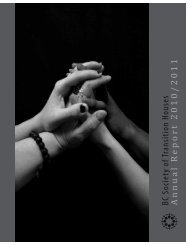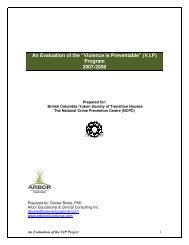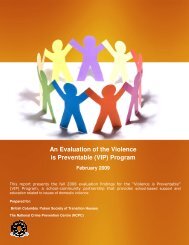reducing barriers to support - BC Society of Transition Houses
reducing barriers to support - BC Society of Transition Houses
reducing barriers to support - BC Society of Transition Houses
You also want an ePaper? Increase the reach of your titles
YUMPU automatically turns print PDFs into web optimized ePapers that Google loves.
WOMEN-CENT RED, HARM REDUCTION F RAMEWORK S<br />
“Women-Centred Care is based on the assumption that women know their own reality<br />
best and that practitioners must listen carefully <strong>to</strong> women describe their reality in their<br />
own words and in their own ways.” 102<br />
Most VAW services are based in women-centred care when it comes <strong>to</strong> <strong>support</strong>ing women fleeing<br />
violence. Yet, this concept is rarely defined and ‘women-centred’ practices vary from agency <strong>to</strong> agency.<br />
Generally, women-centred services refer <strong>to</strong> practices where service providers take the lead from the<br />
women they are serving. Staff provide <strong>support</strong> for the needs women identify as opposed <strong>to</strong> identifying<br />
problem areas for women <strong>to</strong> work on. Women-centred frameworks acknowledge the strengths <strong>of</strong> each<br />
individual woman, respecting her choices and treating her as the “expert” <strong>of</strong> her own life. Service<br />
recipients, <strong>Transition</strong>al House staff, and researchers have roundly suggested that services for women<br />
fleeing violence who have varying levels <strong>of</strong> mental wellness and substance use should be womencentred<br />
as well.<br />
Staff in the VAW sec<strong>to</strong>r engage in harm reduction work every day by providing women with <strong>support</strong> and<br />
<strong>to</strong>ols <strong>to</strong> keep themselves safer, whether they choose <strong>to</strong> leave the abuser or not. Service recipients,<br />
<strong>Transition</strong>al House staff and researchers have noted the usefulness <strong>of</strong> extending this harm reduction<br />
framework when <strong>support</strong>ing women with varying levels <strong>of</strong> mental wellness and substance use as well.<br />
These people argue that, similar <strong>to</strong> VAW advocacy, our role is <strong>to</strong> help women explore their options in a<br />
non-judgmental fashion and <strong>to</strong> respect and <strong>support</strong> the decisions they make. 103 To that end, Patti Bland<br />
and Debi Edmund argue against blanket policies and advocate, instead, for policies that allow women <strong>to</strong><br />
be honest about their mental wellness or substance use. They remind us that strict and rigid rules can<br />
feel oppressive for women but allowing women <strong>to</strong> be open and <strong>to</strong> make decisions for themselves can be<br />
more empowering. 104<br />
The Coalescing on Women and Substance Use team urge service providers <strong>to</strong> take an approach that<br />
combines women-centred and harm reduction principles. Speaking about this framework, they say:<br />
“[o]ften the focus <strong>of</strong> harm reduction efforts does not include <strong>reducing</strong> harms associated<br />
with broader determinants <strong>of</strong> women’s health such as poverty, violence against women,<br />
racism, mothering policies and related harms which differentially affect women. These<br />
fac<strong>to</strong>rs ‐ and their interaction ‐ must be recognized in harm <strong>reducing</strong> service provision<br />
and policy frameworks.” 105<br />
23






